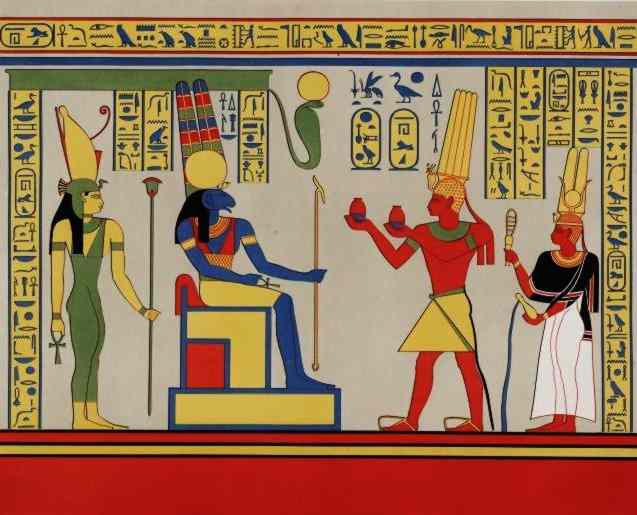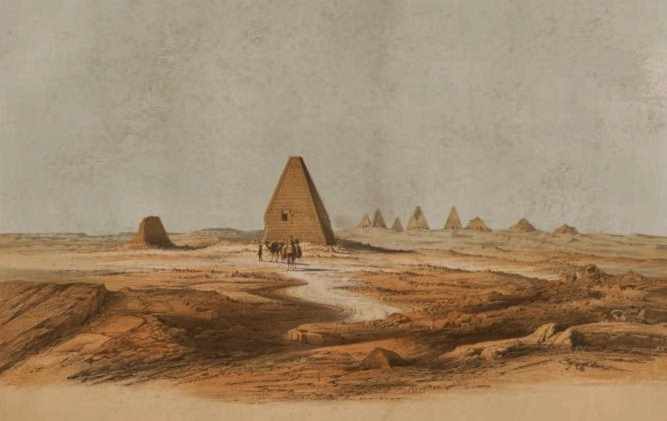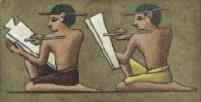AscendingPassage.com
The Egyptian Secrets Library.

The Pyramids of Kush (Cush or Koush)
at Gebel Barkal
The Kingdom of Kush, deep in modern Sudan, was conquered by Egypt in the Eighteenth Dynasty (about 1500 BC). The old capital of Kerma was destroyed and a new capital was built at Napata from which viceroys ruled what was then Egypt's most southern province. In the chaos following the end of the New Kingdom, Kush was left to its' own devices. A strong leadership arose in the eighth century BC and proclaimed this southern kingdom to be the true worshipers of the Egyptian god Amun-Re and the true heirs of the culture of Egypt.

Pharaoh and a Temple Chantress present offerings to Amon-Re.
The lady on the left wears the crown of Lower and Upper Egypt.
Art from Gebel Barkal, by Ernst Weidenbach, 1845.
They made good this claim by conquering all of Egypt, installing themselves as the 25th Dynasty under King (then Pharaoh) Piye (746-716 BC). Piye and his successors were patrons of Egyptian style art, and they revived an ancient Egyptian tradition: Pyramids.
The Pyramids of Gebel (Jebel) Barkal
Early travelers on the Nile believed that little of interest lay beyond the great stone monuments of Abu Simbel. Only a few lonely outposts of Egyptian culture fading into the distance of Africa were known when James Bruce, in 1772, brought back word of not only the ruins of a great civilization, but pyramids!
John Lewis Burckhardt, author of "Travels in Nubia" (portions of which are reprinted starting here
), wrote in 1819: "I believe (Soleb) to be the most southern specimen of Egyptian architecture, for I was credibly informed that no ancient buildings whatever are to be found in the southern parts of Mahass, or in Dongola." Mr. Burckhardt elsewhere wrote of the supposed inaccuracy of Mr. Bruce's claims and it is to be presumed that Bruce's tales of southern pyramids were too fantastic for this hard-bitten explorer to believe.
Yet pyramids there are, well over 200 of them, and although far smaller than their northern counterparts, the pyramids of Nubia have their own mysteries. The first group was built (by Piye and his successors) at Napata, additional pyramids are found at El Kurru and Nuri/Gebel Barkal. Latter the capital and thus the building of pyramids shifted to Meroe.

The mountain of Gebel Barkal with pyramids on the left,
ruins of the temple at right. By Ernst Weidenbach, 1845.
Gebel Barkal
Gebel means mountain, Gebel Barkal is a butte about 300 feet tall that became the sacred center of Kush, an important nexus for the Egyptians and the Nubians. Pharaoh Taharqa, the greatest of the 25th Dynasty Pharaohs, built an important complex of temples at Gebel Barkal to honor Amun-Re, and some pyramids were constructed there.

The pyramids of Gebel Barkal
by Ernst Weidenbach, 1845
Naga


Both engravings of Naga by Ernst Weidenbach.

Temple Art from Naga
by Ernst Weidenbach, 1845.
The story now shifts even further south to the beautifully named
city of Meroe, where the candle burned yet awhile longer:
The Pyramids of Meroe.

Countless beautiful 19th century images of ancient Egypt
and 75 pages of architecture, art and mystery
are linked from the library page:

The Egyptian Secrets Library











